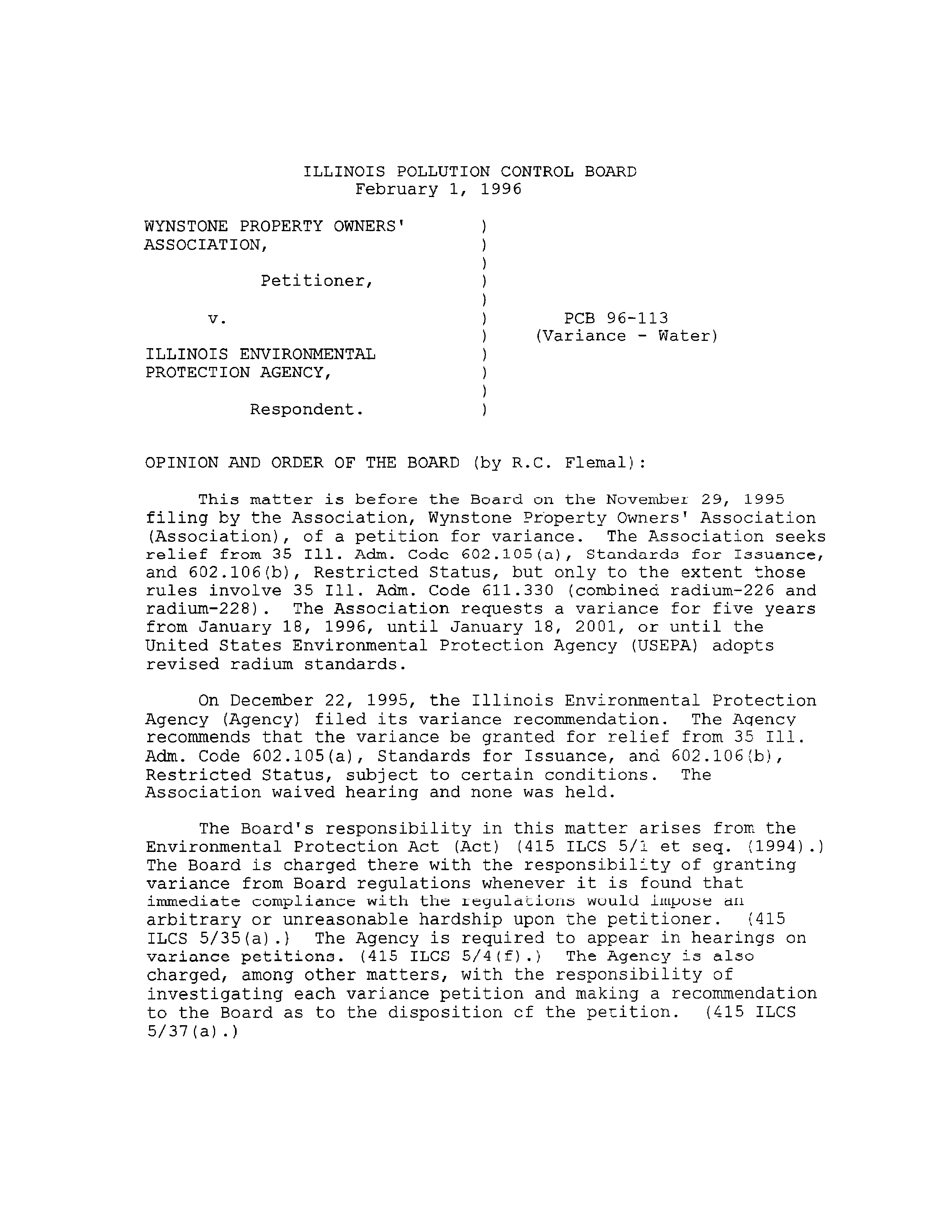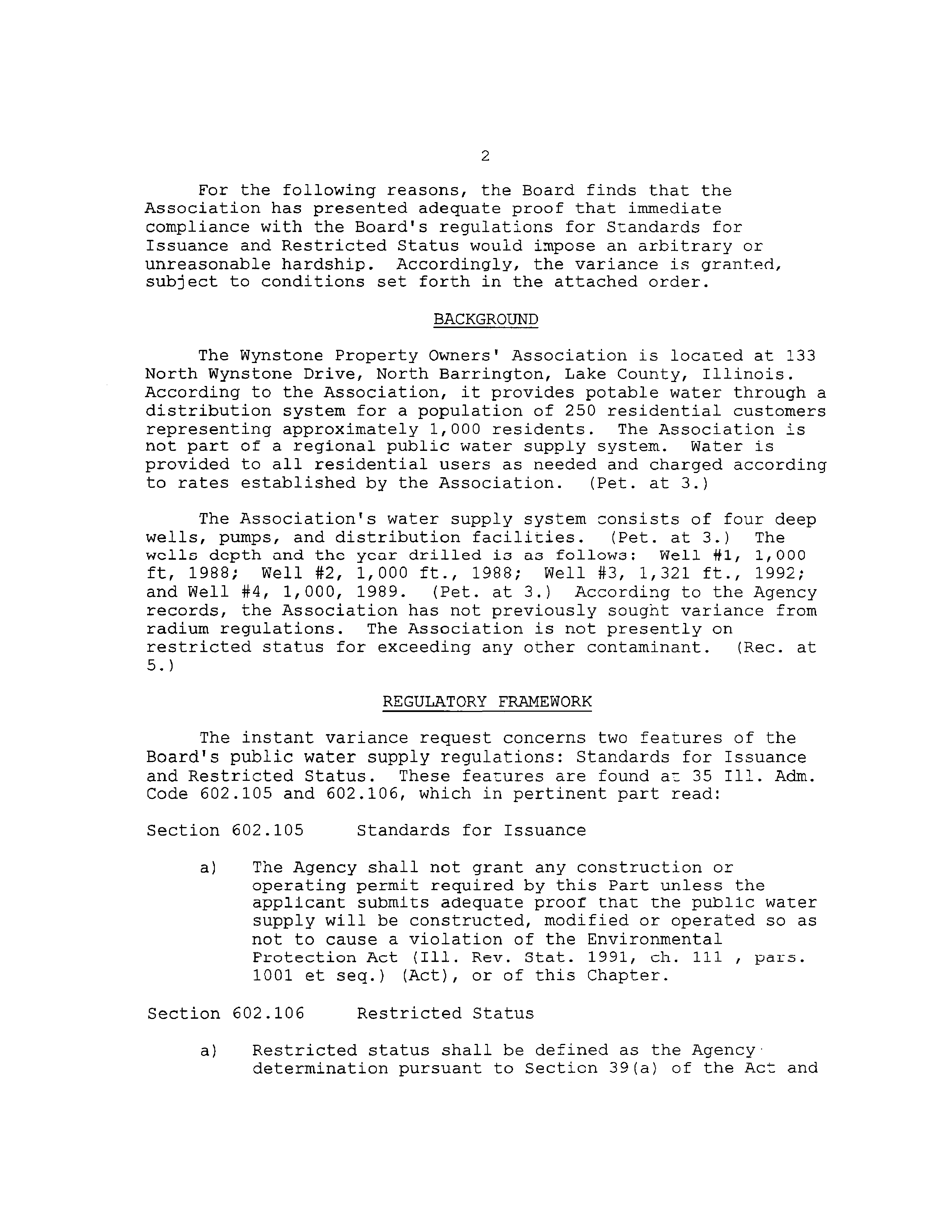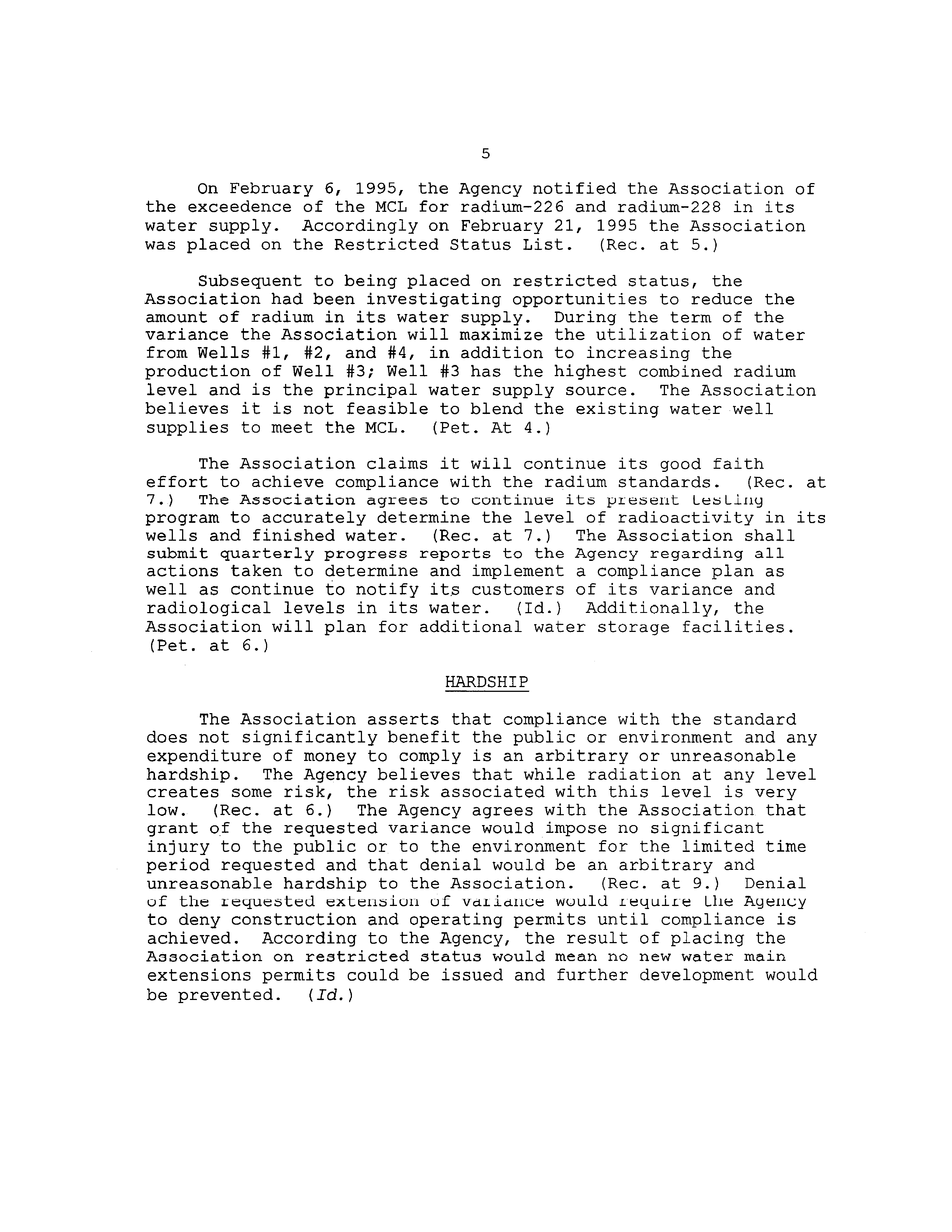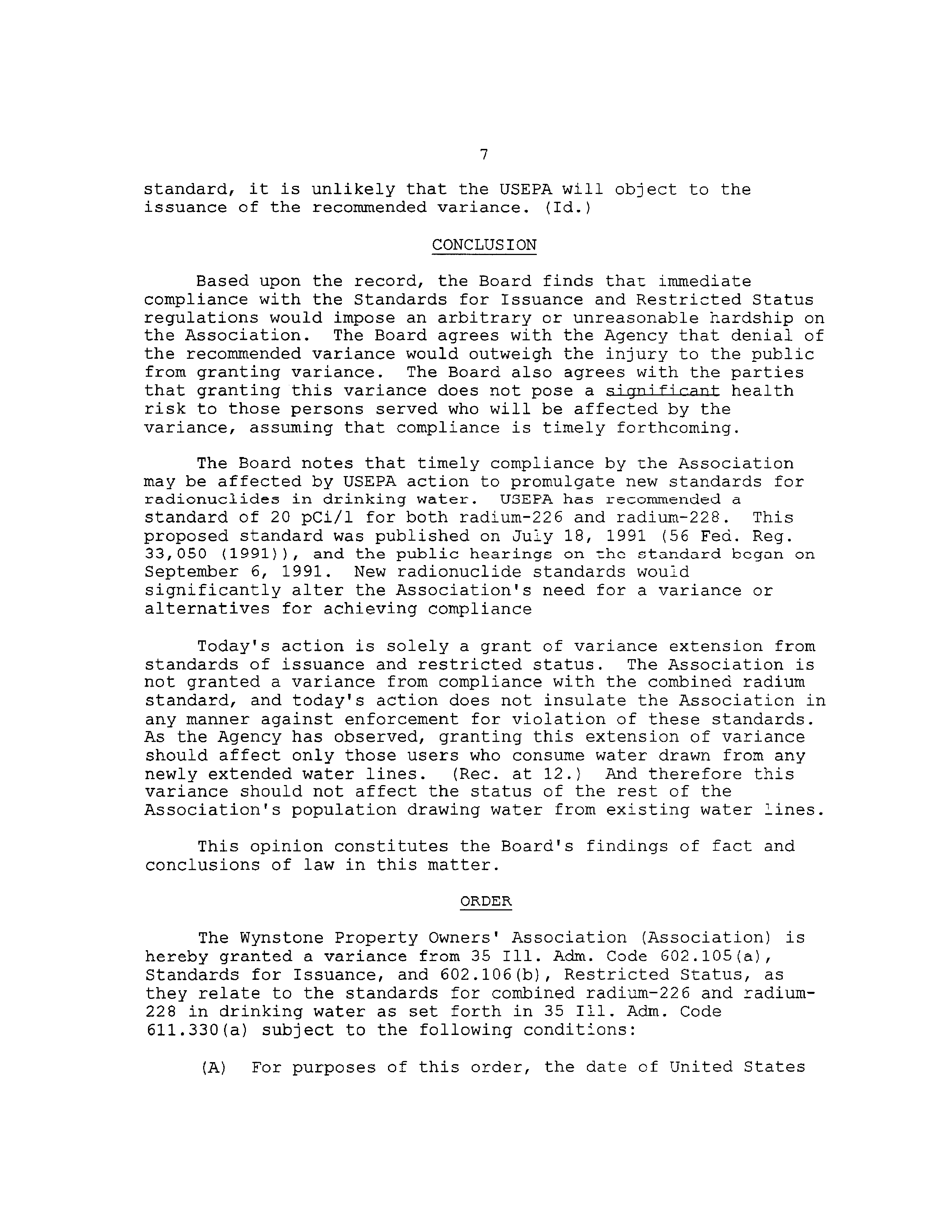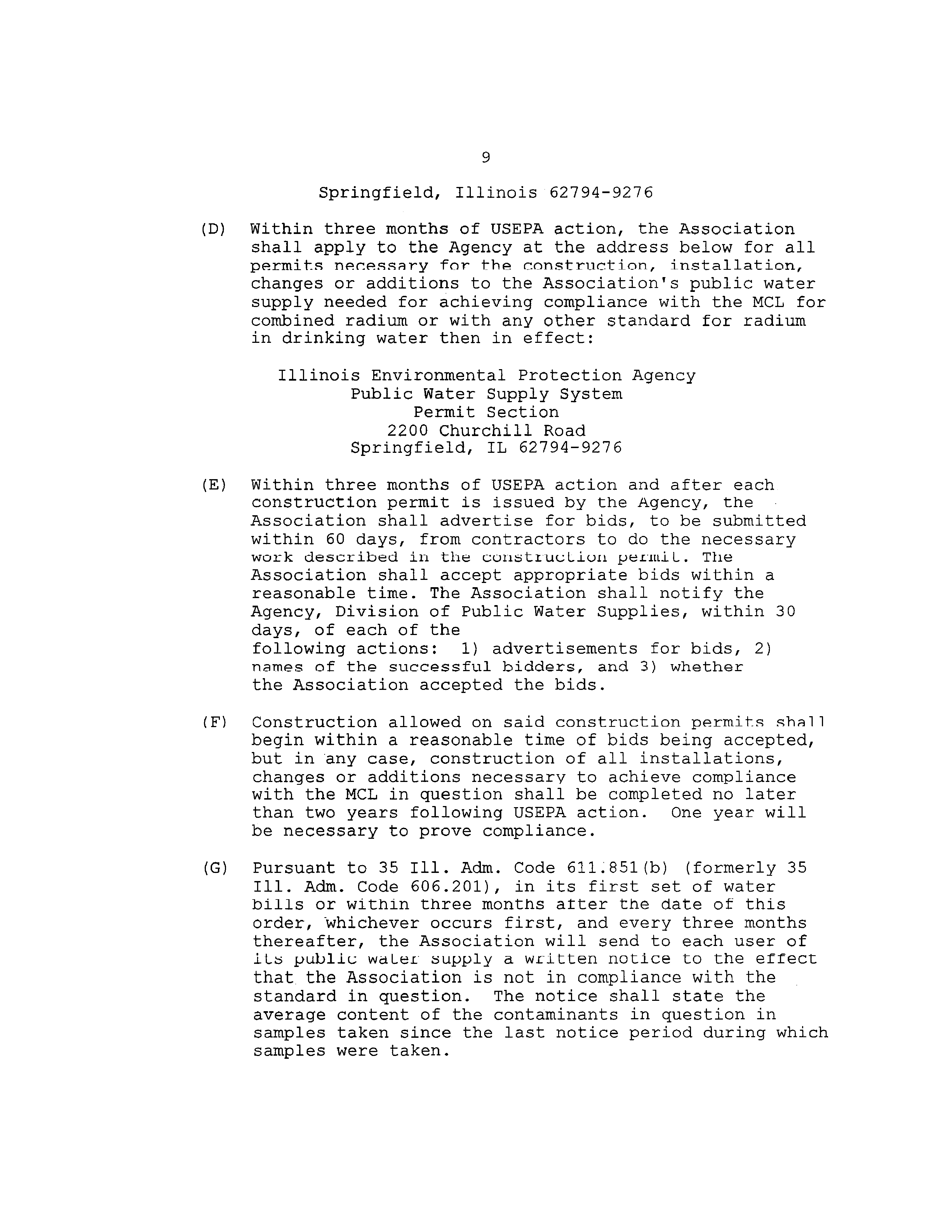ILLINOIS POLLUTION CONTROL
BOARD
February
1,
1996
WYNSTONE PROPERTY OWNERS’
ASSOCIATION,
Petitioner,
v.
)
PCB 96—113
(Variance
-
Water)
ILLINOIS ENVIRONMENTAL
PROTECTION AGENCY,
Respondent.
OPINION
AND
ORDER OF THE BOARD
(by R.C.
Flenal):
This
matter
is
before the Board on the November 29,
1995
filing by the Association, Wynstone Prbperty Owners’ Association
(Association),
of
a petition for variance.
The Association seeks
relief
from
35
Ill. Adm.
codc 602.lOS(a),
Standarda
for
Issuance,
and 632.106(b), Restricted Status,
but only to the extent those
rules involve 35
Ill. Adn. Code
611.330
(combined radium—226 and
radium—228)
.
The Association requests a variance for five years
from January 18,
1996,
until January 18,
2001,
or until the
United States Environmental Protection Agency
(USEPA)
adopts
revised radium standards.
On December 22,
1995,
the Illinois Environmental Protection
Agency
(Agency)
filed its variance recommendation.
The Aciency
recommends that the variance be granted for relief from 35 Ill.
Adi’a.
Code
602.105(a),
Standards for Issuance,
and 602.106(b),
Restricted Status,
subject to certain conditions.
The
Association waived hearing and none was held.
The Board’s responsibility in this matter arises from the
Environmental Protection Act
(Act)
(415 ILCS 5/1 et seq.
(1994)
.)
The Board
is charged there with the responsibility of granting
variance from Board regulations whenever it
is found that
immediate compliance with the
L-egulations would ±itipo~e
dl!
arbitrary or unreasonable hardship upon the petitioner.
(415
ILCS
5/35(a)
.)
The Agency is required to appear in hearings on
variance petitiono.
(415 ILCS 5/4(f).)
The Agency is also
charged,
among other matters, with the responsibility of
investigating each variance petition and making a recommendation
to the Board as to the disposition cf the petition.
(415 ILCS
5/37(a).)
2
For the following reasons,
the Board finds
that the
Association has presented adequate proof that immediate
compliance with the Board’s regulations for Standards for
Issuance and Restricted Status would impose an arbitrary or
unreasonable hardship.
Accordingly, the variance is granted,
subject to conditions set forth in the attached order.
BACKGROUND
The Wynstone Property Owners’ Association is located at 133
North Wynstone Drive, North Barrington, Lake County,
Illinois.
According to the Association,
it provides potable water through a
distribution system for a population of 250 residential customers
representing approximately 1,000 residents.
The Association is
not part or
a regional public water supply system.
Water
is
provided to all residential users
as needed and charged according
to rates established by the Association.
(Pet.
at
3.)
The Association’s water supply system consists of four deep
wells, pumps, and distribution facilities.
(Pet.
at 3.)
The
wells dcpth and the year drilled
is
as
follows:
Well
ff1,
1,000
ft,
1988;
Well
#2,
1,000
ft.,
1988;
Well
#3,
1,321
ft.,
1992;
and Well
#4,
1,000,
1989.
(Pet.
at 3.)
According to the Agency
records,
the Association has not previously sought variance from
radium regulations.
The Association is not presently on
restricted status for exceeding any other contaminant.
(Rec.
at
5.)
REGULATORY FRAMEWORK
The instant variance request concerns two features of the
Board’s public water supply regulations:
Standards for Issuance
and Restricted
Status.
These features are found at
35
Ill. Adm.
Code 602.105 and 602.106,
which in pertinent part read:
Section 602.105
Standards for Issuance
a)
The Agency shall not grant any construction or
operating permit required by this Part unless the
applicant submits adequate proof
tflat tne public water
supply will be constructed, modified or operated so
as
not to cause a violation of the Environmental
Protection Act
(Ill.
Rev.
Stat.
1991,
ch.
111
,
pars.
1001
et seq.)
(Act),
or of this Chapter.
Section 602.106
Restricted Status
a)
Restricted status shall be defined
as the Agency
determination pursuant to Section 39(a)
of the Act and
3
Section 602.105,
that
a public water supply facility
may no longer be issued a construction permit without
causing a violation of the Act or this Chapter.
b)
The Agency shall publish and make available to the
public,
at intervals of not more than six months,
a
comprehensive and up-to-date list of supplies subject
to restrictive status and the reasons why.
Section 611.330
Radium and Gross Alpha Particle Activity
The following are the MCL’s for radium-226 and radium-228.
a)
Combined radium-226 and radium-228
-
5 pCi/L.
The principal effect of these regulations is to provide that
public water supply systems are prohibited from extending water
service,
by virtue of not being able
to
obtain the requisite
permits,
unless
and
until
their
water
meets
all
of
the
standards
for public water supplies.
In determining whether any variance is to be granted,
the
Act requires the Board to determine whether
a petitioner has
presented adequate proof that immediate compliance with the Board
regulations at issue would impose an arbitrary or unreasonable
hardship.
(415 ILCS 5/35(a)
(1994).)
Furthermore,
the burden is
upon
petitioner
to show that
its claimed hardship
outweighs the
public interest in attaining compliance with regulations designed
to protect the public.
(Willowbrook Motel
v.
Pollution Control
Board
(1st Dist.
1977),
135 Ill. App.
3d
343,
481 N.E.2d 1032.)
Only with such
a showing can the claimed hardship rise to the
level of arbitrary or unreasonable hardship.
A further feature of
a variance
is that
it
is, by its
nature,
a temporary reprieve from compliance with the Board’s
regulations
(Monsanto Co.
v.
IPCB
(1977),
67 Ill.2d 276,
367
N.E.2d 684),
and compliance is to be sought regardless
of the
hardship which the task of eventual compliance presents an
individual polluter.
(Id.)
Accordingly,
except in certain
special circumstances,
a petitioner is required,
as
a condition
to grant of variance,
to commit
to
a plan which is reasonably
calculated to achieve compliance within the term of the variance.
A grant of variance from Standards for Issuance and
Restricted Status does not absolve the Association from
compliance with the drinking water standards at issue,
and does
not insulate the Association from possible enforcement action
brought for violation of those standards.
The underlying
standards remain applicable
to the Association regardless
of
4
whether variance
is granted or denied.
Standards for combined radium in drinking water were first
adopted as National Interim Primary Drinking Water Regulations
(NIPDWRs)
by the USEPA in 1976.
The standard adopted was
.5
pci/l
for the sum of the two isotopes of radium,
radium-226 and radium-
228
(“combined radium”).
Shortly thereafter Illinois adopted the
same limits.
Although characterized as
“interim” limits,
these
standards nevertheless are the maximum contaminant levels under
both federal and Illinois law,
and will remain so unless modified
by the USEPA’
Since their original promulgation,
the current radium
standards have been under review at the federal level.
The USEPA
first proposed revision ot the standards in October 1983 in an
Advance Notice of Proposed Rulemaking
(48
Fed.
Reg.
45502)
.
It
later republished this advance notice in September 1986
(51 Fed.
Reg.
34836).
On June
19,
1991,
Lhe USEPA announced a proposal to
modify both standards.
USEPA proposes to replace the 5 pCi/i
combined radium standard by separate standards of
20 pCi/i each
for radium-226 and radium 220.
This change was to be promulgated by April
1995,
but this
deadline was later extended to September 1995.
However, Congress
has prohibited
funds to promulgate final radionuclide standards
for fiscal years 1994 and 1995.
Mr.
Joseph Harrison,
Chief of
the Safe Drinking
Water flivision,
TTSEPA Region
v, announced that
in light of the projected proposal for the relaxed standard, the
USEPA would not force any municipality to spend funds to comply
with the federal combined standard.
Most recently the Federal
Register has indicated that radionuclide standards are no longer
scheduled for a specific final regulatory action date.
(60 Fed.
Reg.
60656, November 28,
1995.)
COMPLIANCE PLAN
As referenced above, the current combined standard for
radium-226 and radium-228
is
5 pCi/L.
The Association’s most
recent water supply analyses,
completed on August
8,
1995,
showed
a combined radium content of 8.1 pCi/U.
(Kec.
at
‘A.)
The b.i
pCi/L was obtained from composite samples compiled from four
consecutive quarterly
samples.
1
In anticipation of USEPA revision of the radium standard,
the
legislature amended the Act at Section 17.6 in 1988 to provide that
any new federal radium standard immediately supersedes the current
Illinois standard.
5
On February
6,
1995,
the Agency notified the Association of
the exceedence of the MCL for radium-226 and radium-228 in its
water supply.
Accordingly on February 21, 1995 the Association
was placed on the Restricted Status List.
(Rec.
at
5.)
Subsequent to being placed on restricted status,
the
Association had been investigating opportunities to reduce the
amount of radium in its water supply.
During the term of the
variance the Association will maximize the utilization of water
from Wells
#1,
#2, and #4,
in addition to increasing the
production
of Well #3; Well #3 has the highest combined radium
level and is the principal water supply source.
The Association
believes it is not feasible to blend the existing water well
supplies to meet the MCL.
(Pet. At 4.)
The Association claims it will continue its good faith
effort to achieve compliance with the radium standards.
(Rec.
at
7.)
The Association agrees
to continue
its present
LesLuiiy
program to accurately determine the level of radioactivity in its
wells and finished water.
(Rec.
at 7.)
The Association shall
submit quarterly progress reports to the Agency regarding all
actions taken to determine and implement
a compliance plan
as
well as continue to notify its customers of its variance and
radiological levels in its water.
(Id.)
Additionally,
the
Association will plan for additional water storage facilities.
(Pet.
at
6.)
HARDSHIP
The Association asserts that compliance with the standard
does not significantly benefit the public or environment and any
expenditure of money to comply is an arbitrary or unreasonable
hardship.
The Agency believes that while radiation at any level
creates some risk,
the risk associated with this level
is very
low.
(Rec.
at
6.)
The Agency agrees with the Association that
grant of the requested variance would impose no significant
injury to the public or to the environment for the limited time
period requested and that denial would be an arbitrary and
unreasonable hardship to the Association.
(Rec.
at
9.)
Denial
of
the
requested
extension
of
vaLidnoc
would require
Llie Agency
to
deny
construction
and
operating permits until compliance is
achieved.
According
to
the Agency,
the result of placing the
Association
on
restricted
status
would
mean
no
new
water main
extensions
permits
could
be
issued
and
further
development would
be
prevented.
(Id.)
6
ENVIRONMENTAL
IMPACT
The Association has not formally assessed the effect of this
variance on the environment.
(Pet. At 5.)
However, the
Association
is
of the opinion that
granting the variance will not
cause harm to the environment or to the people served by the
wells
and
distribution
system
in
question.
(Id.)
The
Agency
believes
an
increase
in
the
allowable
concentration for contaminants in question “should cause no
significant health risk for a limited population served by new
water main extensions for the time period of this recommended
variance”.
(Rec.
at 8.)
The Agency cites the testimony
presented by Richard E. Toohey,
Ph.D.,
at the June
25,
1985
hearing in PCB 85-54 and R85-14,
the Proposed Amendments
to
Public Water Supply Regulations,
35
Ill. Adm. Code 602.105 and
602.106,
as well as the updated testimony presented by Dr. Toohey
in the Board’s hearing ror a variance requested by the
Association
of
Braidwood
in Association of Braidwood v.
IEPA,
(June
21,
1990),
PCB
89-212,
to
show
additional
information
regarding
combined
radium
levels.
(Rec. at
7.)
The
Agency
notes that the variance should affect only those users who
consume water drawn from any newly extended water lines.
(Rec.
at
11.)
CONSISTENCY WITH FEDERAL LAW
The Agency states that the requested variance for relief
from 35
Iii. Adm. Code
602.105(a)
and 602.106(b) may be granted
consistent with the Safe Drinking Water Act
(SDWA),
PT
QR-52T~,
as
amended by PL 96—502,
42 U.S.C.
300(f)
and corresponding
regulations
(40
CFR Part
141)
because the variance does not grant
relief
from
compliance
with
the national primary drinking
regulations.
(Rec.
at
10.)
The Agency states that granting a
variance
from
the effects of restricted status affects State and
not federal law and regulations;
a variance from the effect of
restricted status would allow water main extensions, under the
Act and Board regulations.
(Rec.
at
10.)
The Agency further
states that the recommended variance is not a variance from
US~J?A’snational primary drinking water regulations and does
suspend the effect of the SDWA.
(Id.)
The Agency asserts that
a
federal variance is not at issue and there should be no risk to
the state of Illinois of loss of primacy.
(Id.)
The Agency
states that the Association will remain subject to the
possibility of enforcement for violations of the MCL for the
contaminants in question under state and federal law.
(Id.)
The
Agency concludes that because continuing progress is being made
towards compliance while awaiting final promuLgation of the
7
standard,
it
is
unlikely
that
the USEPA will object to the
issuance
of
the
recommended
variance.
(Id.)
CONCLUS ION
Based
upon
the
record,
the
Board
finds
that
immediate
compliance
with
the
Standards
for
Issuance
and
Restricted
Status
regulations
would
impose
an
arbitrary or unreasonable hardship on
the
Association.
The
Board
agrees
with
the
Agency
that
denial
of
the
recommended
variance
would
outweigh
the
injury
to
the
public
from
granting
variance.
The
Board also agrees with the parties
that granting this variance does not pose a
significant health
risk to those persons served who will be affected by the
variance, assuming that compliance
is timely forthcoming.
The
Board
notes
that
timely compliance by the Association
may
be
affected
by
USEPA
action
to
promulgate
new
standards
for
radionuclides
in drinking water.
USEFA has recommended
a
standard of 20 pCi/l
for both radium-226 and radiun-228.
This
proposed standard was published on July 18,
1991
(56 Fed.
Reg.
33,050
(1991)),
and the public
hearings
on
the standard began
on
September
6,
1991.
New radionuclide standards would
significantly alter the Association’s need for a variance or
alternatives
for achieving compliance
Today’s action is solely a grant of variance extension from
standards of issuance and restricted status.
The Association is
not granted a variance from compliance with the combined radium
standard, and today’s action does not insulate the Association in
any manner against enforcement for violation of these standards.
As the Agency has observed,
granting this extension of variance
should affect only those users who consume water drawn from any
newly extended water lines.
(Rec.
at 12.)
And
therefore
this
variance should not affect the status of the rest of the
Association’s population drawing water from existing water lines.
This opinion constitutes the Board’s
findings of fact and
conclusions of law in this matter.
ORDER
The Wynstone Property Owners’ Association (Association)
is
hereby granted a variance from 35
Ill.
Acim.
Code 602.105(a),
Standards
for
Issuance,
and
602.106(b),
Restricted
Status,
as
they
relate
to
the
standards
for
combined
radium—226
and
radium-
228
in
drinking
water
as
set
forth
in
35
Ill.
Adm.
Code
611.330(a)
subject
to
the
following
conditions:
(A)
For purposes
of this order,
the date
of United States
8
Environmental
Protection
Agency
(USEPA)
action
consists
of the earlier date
of the following:
(1)
Date of promulgation by the USEPA
of any
regulation
which
amends
the
maximum
concentration
level
for
combined
radium,
either
of
the
isotopes
of
radium,
or
the
method
by
which
compliance
with
a
radium
maximum
contaminant level is
demonstrated;
or
(2)
Date
of
publication of notice by the USEPA that no
amendments
to
the
5
pCi/l
combined
radium
standard
or
the
method
for
demonstrating
compliance
with
the
5
pCi/i
standard
will
be
promulgated.
(B)
Variance
shall
terminate on the earliest of
the
following
dates:
(1)
Two
years
following
the
date
of
USEPA
action;
or
(2)
February
1,
2001; or
(3)
When analysis pursuant to 35
Ill.
Adm.
Code
611.720,
or any compliance with standards then in
effect,
shows compliance with standards
for radium
in drinking water then in effect.
(C)
In
consultation
with
the
Illinois
Environmental
Protection
Agency
(Agency),
the Association shall
continue a sampling program to determine
as accurately
as possible the level of radioactivity in its wells and
finished water.
Until this variance expires,
the
Association shall collect quarterly samples of water
from the distribution system at locations approved by
the Agency.
The Association shall composite the
quarterly samples
from each location separately and
shall
analyze them annually by a laboratory certified
by the State of Illinois for radiological analysis so
as to determine the concentration of radium—226 and
.Ladlum—228.
At the option of the Association,
the
quarterly samples may be analyzed when collected.
The
results of the analyses shall be reported within 30
days
of receipt
of each analysis
to;
Illinois
Environmental
Protection Agency
Compliance Assurance Section
Drinking
Water
Quality
Unit
Bureau
of
Water
P.O.
Box
19276
9
Springfield,
Illinois
62794—9276
(D)
Within
three
months
of
USEPA
action,
the
Association
shall
apply
to
the
Agency
at
the
address
below
for
all
permits necessary for
the construction,
installation,
changes
or
additions
to
the Association’s public water
supply
needed
for
achieving
compliance
with
the
MCL
for
combined
radium
or
with
any
other
standard
for
radium
in drinking water then in effect:
Illinois Environmental Protection Agency
Public
Water
Supply
System
Permit
Section
2200
Churchill
Road
Springfield,
IL
62794—9276
(E)
Within
three
months
of
USEPA
action
and
after
each
construction
permit
is
issued
by
the
Agency,
the
Association shall advertise for bids,
to be submitted
within
60 days,
from contractors to do the necessary
work
described
in
the
construc
Lion
penal
L.
The
Association
shall
accept
appropriate
bids
within
a
reasonable time.
The Association shall notify the
Agency,
Division
of
Public
Water
Supplies,
within
30
days,
of each of the
following actions:
1)
advertisements
for bids,
2)
names
of
the successful bidders,
and
3) whether
the Association accepted the bids.
(F)
Construction
allowed
on
said
construction
permits
shall
begin within a reasonable time of bids being accepted,
but in any case,
construction of all installations,
changes or additions necessary to achieve compliance
with the MCL in question shall be completed no
later
than two years following USEPA action.
One year will
be necessary to prove compliance.
(G)
Pursuant to 35 Ill. Adm.
Code 611.851(b)
(formerly 35
Ill. Adm.
Code
606.201),
in its first set of water
bills or within three months atter the date of this
order, ~whicheveroccurs first,
and every three months
thereafter,
the Association will send to each user of
iLs
public
waLer
supply
a
written
notice
to
the
effect
that
the
Association
is
not
in
compliance
with
the
standard in question.
The notice shall
state the
average content of the contaminants in question in
samples
taken
since
the
last
notice
period
during
which
samples
were
taken.
10
(H)
Pursuant
to
35
Ill.
Adm.
Code
611.851(b)
(formerly
35
Ill.
Adm.
Code
606.201),
in
the
first
set
of
water
bills
or
within
three
months
after
the
date
of
this
order,
whichever
occurs
first,
and
every
three
months
thereafter,
the
Association
will
send
to each user of
its
public
water
supply
a
written
notice
to
the
effect
that
the
Association
has
been
granted
by
the
Illinois
Pollution
Control
Board
a
variance
from
35
Ill.
Adrn.
Code
602.105(a),
Standards
of
Issuance,
and
35
ill.
Adm.
Code
602.106(b),
Restricted
Status,
•as
they
relate
to
the
MCL
standard
in
question.
(I)
Until
full
compliance
is
achieved,
the
Association
shall take all reasonable measures with its existing
equipment to minimize the level
of contaminants in its
finished drinking water.
(J)
The
Association
shall
provide
written
progress
reports to the Agency at the address below every
six months concerning steps
taken
to comply with
the
paragraphs
C,
D,
E,
F,
G and H of this order.
Progress
reports
shall
quote each of said
paragraphs
and
immediately
below
each
paragraph
state
what
steps
have
been
taken
to
comply
with
each
paragraph:
Illinois
Fnvironmental
Protection Agency
Division of Public Water Supply
Field Operations Section
2200
Churchill
Road
Springfield,
Illinois
62794—9276
IT
IS
SO
ORDERED.
If
the
Wynstone
Property Owners’ Association chooses
to
accept
this
variance
subject
to
the
above
order,
within
forty-
five days of the date of this order,
the Wynstone Property
Owners’ Association shall execute and forward to:
Stephen
C.
Ewart
Division
of Legal Counsel
Illinois
Environmental
Protection
Agency
2200
ChurchIll
Road,
P.O.
Box
19276
Springfield,
Illinois
62794—9276
a
Certificate
of
Acceptance
and
agreement
to
be
bound
to
all
terms
and
conditions
of
the
granted
variance.
The
45-day
period
shall
be
held
in
abeyance
during
any
period
that
this
matter
is
appealed.
Failure
to
execute
and
forward
the
certificate
within
11
45—days renders this variance void and of no force and effect as
a shield against enforcement of rules from which this variance is
granted.
The
form
of
the
certificate
is
as
follows.
I
(We),
,
hereby
accept
and
agree
to
be
bound
by
all
terms
and
conditions
of
the
order
of
the
Illinois
Pollution
Control
Board
in
PCB
96-113,
February
1,
1996.
The
Association
Authorized
Agent
Title
Date
Section 41 of the Environmental Protection Act,
(415 ILCS
5/41
(1994)), provides for appeal of final orders of the Board
within 35 days of the date of service of this order.
The Rules
of the Supreme Court of Illinois establish filing requirements.
(See also 35
Ill.
Adm.
Code 101.246, Motion for Reconsideration.)
I, Dorothy M.
Gunn,
Clerk of the Illinois Pollution Contrcl
Board, hereby certify that the abovegpnion
and order was
adopted on the
/~‘~
day
of
_________________________,
1996,
by
a
vote
of
____________
~
4.
Dorothy
M.
G,kthn,
Clerk
Illinois
Poé4ution
Control
Board
